Fundamental changes in the design and manufacture of spectacle lenses are allowing us to offer a level of clarity, visual comfort and personalization that we could only dream of just a few years ago. For this, we can thank the integration of computer technology—from aberrometers that measure wavefront distortion to reduce higher-order aberrations to free-form production that allows us to apply any type of curve to a lens surface.
The market continues to expand with new products at a rate that is nothing short of spectacular, especially compared to the early part of my career 30 years ago. Let’s take a look at some of the new lenses, lens treatments and dispensing and processing equipment that have emerged in the past year.
Progressive Addition Lenses

Varilux Physio Enhanced Azio, Essilor.
• Essilor Varilux Physio Enhanced. After studying the ocular anatomy, facial anatomy and reading behavior of more than 200,000 Asian and Indian subjects, Essilor designed a line of lenses to satisfy their unique visual needs. According to the company, these lenses improve acuity and contrast, offer wider fields of view and provide a more natural transition between visual zones than progressive addition lenses (PALs) that are not specifically designed for Asians and Indians.
The lenses also feature Essilor’s Wavefront Advanced Vision Enhancement technology (W.A.V.E. Technology 2). Because this process accounts for variations in pupil size due to age, lighting conditions, prescription and viewing distance, the lenses provide optimal vision at all light levels with fewer higher-order aberrations. The lenses also employ Essilor’s Dual Optix technology (design elements are on both the front and back surfaces) and are free-form processed.
Physio Enhanced multicultural lenses are available in 1.50, Trivex, polycarbonate, 1.60, 1.67 and 1.74 in clear, Transitions VI and Xperio polarized forms (not every material is available in every form). Non-presbyopes can experience similar benefits with the company’s Azio Single Vision lenses.
-Varilux Physio Enhanced Azio. People of Asian descent are frequently myopic. Because their eyes often have longer axial lengths, the optic axes sweep broader areas of the lenses. As a result, lens designs with wider fields of view are beneficial. Essilor’s research also indicates that the less prominent facial characteristics of Asians impact how they wear their frames—leading to differences in vertex distance, pantoscopic tilt and face form, compared to other groups. Finally, the study revealed that Asians tend to hold reading material closer to their eyes than other populations, leading to increased convergence.
-Varilux Physio Enhanced India. People of Indian descent are often hyperopic. Because their eyes usually have shorter axial lengths, the optic axes sweep narrower areas of the lenses. As a result, peripheral distortion can be disturbing, making softer lens designs advantageous. Essilor’s research indicates that the more prominent facial characteristics of Indians impact how they wear their frames—leading to differences in vertex distance, pantoscopic tilt and face form, compared to other groups. Finally, the study revealed that Indians also tend to hold reading material close to their eyes, leading to increased convergence—the opposite of what would be expected in hyperopes.

Varilux Physio Enhanced India, Essilor.
• Hoya Hoyalux iD MyStyle. The newest additions to Hoya’s iD family of PALs, these lenses are available in two levels of personalization—the iD MyStyle and the iD MyStyle Signature. The MyStyle iDentifier, an interactive consultation and ordering tool found on the company’s website, determines the amount of personalization. It accounts for frame parameters, PD, fitting center heights and position-of-wear measurements, as well as the patient’s visual environment, lifestyle preferences and multifocal history. Results are summarized in a personal vision profile that permits the patient to select from two offerings based on their visual and financial needs.-Varilux Physio Enhanced Fit. This lens brings some degree of personalization to the Physio Enhanced line of PALs. Essilor reports that only 9% of patients fall within the standard values in their database for position-of-wear measurements (vertex distance, pantoscopic tilt and face form). By including these measurements with the PD and fitting center heights, the company claims this lens offers even better acuity and contrast, wider fields of view and easier transition between visual zones than their regular Physio Enhanced PALs. Essilor recommends using their Visioffice system to take the measurements, but you can take them manually or with another manufacturer’s electronic patient measuring devices (EPMDs).
Varilux Physio Enhanced Fit lenses are available in 1.50, Trivex and polycarbonate in clear, Transitions VI and Transitions XTRActive forms (not every material is available in every form).
Non-presbyopes can experience similar benefits with Essilor’s Fit Single Vision lenses.

Hoyalux iD MyStyle, Hoya
The iD MyStyle combines select information from the MyStyle iDentifier with fitting data from thousands of patients in the company’s database; the iD MyStyle Signature offers a greater degree of personalization by incorporating all of the information from the MyStyle iDentifier in the customization. The lenses are available in three corridor lengths: 11mm, 14mm and 16mm. Like other iD lenses, the add power is split between the front and back surfaces to reduce distortion and is processed using Hoya’s iD FreeForm Design Technology. iD MyStyle lenses are available in 1.50, Trivex, 1.60 and 1.67 in clear and Suntech photochromic forms.
Specialty Lenses
• ChromaGen Vision ChromaGen Lenses. ChromaGen Vision recently released its second generation of ChromaGen lenses, with a reference guide that instructs O.D.s on how to choose the proper colors for specific disorders. The company has expanded the fitting kit from eight to 16 different colored filters (although they appear neutral gray when worn) and has tapped Pech Optical to manufacture the lenses in the United States. Lenses are available in CR-39 and Trivex in any type of single vision, segmented multifocal or PAL they handle. ChromaGen filters are also available in hydrogel contact lenses.
-Lenses for Color Deficiencies. Approximately 10% of all men and 0.5% of all women have some type of color deficiency, a decreased ability to distinguish the differences between certain colors.1 These people have a hereditary defect that causes the pigment in their retinal cones to have an altered spectral sensitivity, which makes it difficult for them to distinguish red from green and blue from yellow. David Harris, Ph.D., the inventor of ChromaGen lenses, found that when a different colored filter is placed over each of a patient’s eyes, it creates a luminous disparity that produces a cortical rivalry, which aids color discrimination. While not a cure, these lenses can still enhance quality of life and enable some people to qualify for previously inaccessible jobs, such as police work or telephone repair.
-Lenses for Dyslexia. Dyslexia is thought to have a visual component because abnormalities in the magnocellular visual pathway, which controls motion and depth perception, can cause people to experience blurring (independent of visual correction), page shimmering, letter or word movement, word reversal and interference from the spaces between words. After years of working with dyslexics, Dr. Harris and his colleague, Chaaban Zeidan, M.Sc., further developed ChromaGen lenses to treat dyslexia. They found that using a different colored filter over each eye alters the speed at which information is processed in the brain, reducing the symptoms of visual dyslexia. In a study of 75 dyslexic ChromaGen-wearing subjects at the University of Liverpool, researchers noted a 35% improvement in reading speed and accuracy using the Wilkins Rate of Reading Test.2
• Rodenstock Canada Manufaktur. The lenses in this collection are individually made for people with extreme ametropias or accommodative and convergence disorders, and for those who have specific vocational and avocational needs. Depending upon the prescription and lens type, they can be traditionally surfaced, free-form processed or even made by hand.
-Single Vision. All minus lenses are aspheric lenticular in design, available in Lentilux 1.70 glass, and come in sphere powers between -6.00 and -24.00 and cylinder powers up to 6.00. Plus lenses come in two forms. The first is an aspheric lenticular design, available in Perfastar 1.50 plastic, and comes in sphere powers between +8.00 and +22.00 and cylinder powers up to 6.00. The second is a lenticular-only design, available in Starlenti 1.50 plastic, and comes in sphere powers between +6.25 and +26.00 and cylinder powers up to 6.00. The lenses are also available with prism power up to 25.00.
-Occupational Segmented Multifocals. There has been a dwindling number of occupational segmented multifocals from which to choose. This should come as no surprise, as manufacturers have had little incentive to continue to produce or modernize them because O.D.s rarely recommend them. However, they can be a source of additional income if properly marketed.
To address this situation, the Manufaktur line includes segmented bifocals and trifocals that are designed for people whose occupation or hobby requires that their near or intermediate be placed in non-traditional areas of a lens. The Ardis Special Reverse bifocal resembles the Rede-Rite bifocal of my youth (an upside-down Ultex A), with the segment at the top for distance viewing and the major portion of the lens for near viewing. The Ardis Special Trifocal has dual Ultex A-like segments. The FZN has distance at the top, intermediate in the middle and near at the bottom. The ZFN has intermediate at the top, distance in the middle and near at the bottom.
The NFN has near at the top, distance in the middle and near at the bottom. All lenses are available in 1.50 glass in sphere powers between -10.00 and +10.00, in cylinder powers up to 6.00 and in add powers between +0.50 and +7.00. Prism can be incorporated at both distance and near. These lenses are well suited for auto mechanics, carpenters, electricians, librarians, pharmacists, pilots, plumbers and shoe sales people. Because they’re only made in glass, caution should be exercised when recommending them for some occupations.
-Lenses for Scuba Diving. Rodenstock has recognized the needs of the growing number of scuba divers by making lenses that can be mounted in diving masks. These plano concave and plano convex lenses are available in 1.50 or 1.70 glass, come in sphere powers between +10.00 and -10.00 and cylinder powers up to 6.00 and are vertex distance compensated.
-Lenses for Collector Eyewear. Rodenstock has also identified a small group of people who want to read with lorgnettes, opera glasses and monocles. Their unusual shapes and small sizes, as well as their intricate mounting systems, require highly individualized lenses. For these aesthetically conscious people, the company now makes modern lenses for these old-fashioned eyewear options.
• Shamir Relax. This is the newest lens designed to combat visual fatigue. Our eyes are constantly changing focus in the office environment as we shift between viewing written documents, computer screens and keyboards, tablets and cell phones. When combined with our seemingly ever-increasing workload, it’s no surprise that even younger people have complaints of tiredness, blurry vision, headaches and tearing.

Shamir Relax
Relax addresses these problems by incorporating an add power of 0.65D in the lower lens area. Shamir claims this reduces accommodative effort by as much as 30%. The lens was designed using the company’s EyePoint Technology and is free-form processed with its Prescriptor software and Direct Lens Technology. It’s available in 1.50, polycarbonate and 1.60 in clear, Transitions and polarized forms (1.50 isn’t available polarized). Although Shamir markets Relax as a single-vision lens, it’s obviously not and requires a minimum fitting height of 16mm.
Photochromic Lenses
• Seiko Sportswear Transitions SOLFX. This is the latest member of Transitions Optical’s SOLFX line of photochromic lenses. These lenses are designed to enhance outdoor visual performance by improving color recognition, contrast and depth perception in a variety of lighting conditions. Although it can be used for many activities, Sportwear’s G-15-like color is ideal for walking, running and hiking, Seiko says. It’s available in single-vision aspheric, Perfas-brand PALs and in Seiko’s new Wrap Tech free-form lens and frame packages (in 6- and 8-base curves). Single-vision lenses are available in 1.67, PALs in Trivex, polycarbonate and Wrap Tech lenses in 1.67.
• Vision-Ease LifeRx FSV. Like all LifeRx lenses, this finished single-vision (FSV) lens uses a photochromic-impregnated film that’s encapsulated just 0.4mm behind the front surface when the polycarbonate monomer is injected into the mold. LifeRx FSV is only available in gray in sphere powers between +2.00 and -6.00 and in cylinder powers up to 2.00. It can be used interchangeably with Vision-Ease’s LifeRx semi-finished single-vision (SFSV) lenses because they share common base curves. In addition to FSV and SFSV lenses, the company also produces a LifeRx aspheric SFSV lens, FT 28 and FT 35 bifocals, a FT 7x28 trifocal, and Illumina and Outlook PALs.
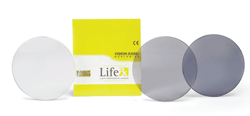
LifeRx FSV, Vision-Ease
• Vision-Ease ChangeRx. Vision-Ease’s newest photochromic lens is meant to be more affordable than its current products, as well as lenses from other manufacturers. ChangeRx uses in-mass technology, a process that uniformly mixes the photochromic molecules throughout the lens monomer. The lens is clearer indoors and activates and fades more rapidly than the best-selling photochromic lens on the market, according to the company. ChangeRx will be offered exclusively in a 1.50 index material whose 1.18 specific gravity is the third lowest available, making it 11% lighter than CR-39. It will be available in brown or gray in FSV (with or without anti-reflective coating) and SFSV forms, a FT 28 bifocal and the Novella PAL. Vision-Ease is hoping to launch ChangeRx later this year or in early 2012.
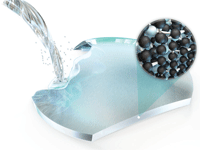
ChangeRx, Vision-Ease
• Carl Zeiss PhotoFusion. In 2010, Carl Zeiss Vision commissioned a market study in Australia, Brazil, China, Germany, Great Britain, Italy and the United States to determine what consumers wanted from photochromic lenses. The 5,896 participants ranked darkness, rapid activation and fade time at the top of their wish lists. The company created a new photochromic process to meet these desires. Zeiss likens its photochromic molecules to soccer balls—in its inactivated state, each molecule resembles a collection of geodesics that intersect to form the pentangular shapes so familiar on a soccer ball.
The compactness of the molecules in this state allows most light to pass through the lens, making it virtually clear. The triangular shapes begin to unfold in cloudy conditions, blocking some light; while in bright sunlight, they fully unfold to block most light. PhotoFusion has an 11% transmission rate at its darkest and a 92% transmission rate at its lightest. It’s also nearly 20% faster to activate and fade than the company’s current photochromic lenses. Zeiss manufactures the lenses in an environmentally responsible manner, using less water, consuming less energy and reducing its carbon footprint, the company says.
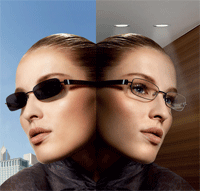
PhotoFusion, Carl Zeiss Vision
Materials and Coatings
• Shanghai Conant Optics Hi-Vex. Distributed in the United Statesby Conant Lens Inc., this lens has an index of refraction of 1.56, which makes it thinner than CR-39 (1.498) and Trivex (1.53), but thicker than polycarbonate (1.59). Its specific gravity is 1.25, so it’s lighter than CR-39 (1.32), but heavier than polycarbonate (1.20) and Trivex (1.11). It has an Abbe value of 46, which means it has less longitudinal chromatic aberration than polycarbonate (31) and Trivex (44), but more than CR-39 (58). Like polycarbonate and Trivex, Hi-Vex meets the requirements of ANSI’s Z87.1 High Velocity Impact Test, making it an appropriate choice for children’s, sports and safety eyewear.
Hi-Vex is also a good option for rimless mountings because the microscopic cracks introduced by drilling won’t cause the holes to expand, which happens in other materials and can lead to lenses loosening and frame misalignment. It shares this advantage with Trivex and some other high-index lens materials, notably 1.67 and 1.70. In addition, the company claims the material is easier to surface and polish than polycarbonate or Trivex. Hi-Vex is available in finished and semi-finished single-vision lenses, a FT 28 bifocal and a short-corridor PAL. Shanghai plans to introduce a polarized lens later this year or in early 2012.
• Ice-Tech Mirror Coatings. Ice-Tech Advanced Lens Technologies completely controls production of this product because it owns the patent on the software that communicates with patented hardware. This gives the company the ability to produce high-quality lenses with quicker turnaround time. Ice-Tech offers 10 specialized mirror colors: black ice, ice blue, ocean blue, chrome, gold, antique gold, cool green, molten lava, rose and ruby ice. These mirrors are produced on an as-needed basis, no matter what quantities are requested.
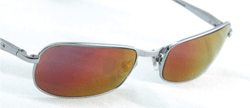
Mirror Coatings, Ice-Tech Advanced Lens Technologies
Sunwear
• Safilo Carrera X-Cede. Available exclusively through authorized dealers, this new collection of plano and prescription sunglasses features an innovative non-film polarization technology. Microscopic nanotechnology receptors embedded in the lenses block reflected glare, while simultaneously admitting those light wavelengths that enhance color. Because the polarization and color enhancement elements are molecularly fused to the lenses, delamination is eliminated.
Safilo has licensed seven labs in the United States to process the lenses. They’re available in NXT in single vision and the Shamir Autograph II Attitude PAL. All lenses come standard with back-surface anti-reflective and front-surface oleophobic coatings. Three solid colors are offered—brown, gray (with a flash silver mirror) and green. Twelve frames are available, ranging from vintage 1980s styles to contemporary designs. The frames are ordered directly from Safilo and drop-shipped to the Carrera X-Cede Rx Lab of the O.D.’s choice for processing.

Carrera X-Cede, Safilo
• VedaloHD VedaloRx. After four years of development, VedaloHD recently released VedaloRx prescription sunwear. Although targeted at golfers, they’re suitable for any outdoor activity. VedaloHD’s research demonstrates that the brain has difficulty rapidly defining color and contrast because of areas of overlap and gaps between chromatic receptors. The use of special equalizing filters can create a greater balance. Designed to enhance acuity, depth perception, and color recognition and contrast, VedaloRx lenses utilize the same proprietary tri-stimulus filtering process (HDL-3C technology) found in VedaloHD plano sunglasses. Unlike traditional tinted or coated lenses, the color elements are infused into the lenses in a patented process called “mass tinting.”
Shamir Optical makes VedaloRx lenses exclusively for VedaloHD. They’re available in NXT in single vision and the Autograph II Attitude PAL (both of which are free-form processed), and come in copper-rose and smoke colors in fixed and Varia photochromic forms. The company just expanded its frame selection from eight to 12, with the addition of the new Stritanium collection. These lightweight 18g frames are made of surgical-grade stainless steel infused with titanium. Green may become an option in the future (it’s available in Europe), and a polarized version is currently being tested.
Dispensing and Processing Equipment
• Hoya Vision Care and Optikam Tech Optikam. The two companies recently announced a partnership to benefit patients of independent eye care practitioners in Canada by cross marketing Optikam Tech’s Optikam EPMD with Hoya’s lens technology.
Like other EPMDs, Optikam can take PDs, fitting center heights and position-of-wear measurements, as well as assist patients in selecting frames, lenses and lens treatments. However, only Hoya’s educational materials, lenses and lens treatments are used in this application. The companies hope that the synergy will enhance the patient’s purchasing experience, giving eye care practitioners an edge in today’s competitive market.
• QSpex Premium Lens System. When in-office lens casting systems were first introduced in the 1980s, it was thought that they would have strong market appeal because they could offer O.D.s greater control of the production process at a lower cost.
Unfortunately, they’ve had limited success due to underdeveloped technologies and marketing missteps by their manufacturers. QSpex Technologies is hoping to change the perception of these systems. Created by Kai Su, Ph.D., a polymer chemist and 31-year veteran of the vision care industry, the QSpex Premium Lens System is able to produce single-vision lenses and PALs with any combination of lens treatments (photochromic, polarized, and scratch-resistant and anti-reflective coatings) in about 30 minutes.
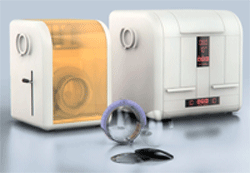
QSpex Premium Lens System
All treatments are applied to the inside surface of each mold, becoming part of the lens during the polymerization process so they can’t crack, craze or peel. Unlike some earlier systems, the QSpex Premium Lens System employs plastic molds that are disposed of after each use. All lenses are made with the proprietary AQuity155 resin, which has an index of refraction of 1.547, a specific gravity of 1.15 and an Abbe value of 40, which blocks 100% of UV light. They’re available in sphere powers between +2.00 and -4.25, in cylinder powers up to 2.00 and in add powers between +1.00 and +3.00. QSpex claims these powers cover about 84% of all prescriptions and estimates 30% to 50% in savings when compared to traditional and free-form lens manufacturing methods.
• Rodenstock Lens Consultation iPad App. Rodenstock heralds this no-charge iPad app as the first of its kind in the industry. It enables O.D.s to provide their patients with a demonstration (including 3-D animation) of the differences between some of their products. With a total of five modules, the application is divided into two areas—one that requires registration and one that doesn’t. For example, in the Professional Consulting module, patients can be shown the differences in fields of view between one of Rodenstock’s traditional PALs and one of its new personalized PALs. This is made all the more impressive because the O.D. can input a patient’s PD and position-of-wear data for a highly individualized demonstration.
Dr. Patrick is assistant professor of optometry at Nova Southeastern University College of Optometry in Ft. Lauderdale, Fla.
1. Haegerström-Portnoy G. Color Vision. In: Rosenbloom AA, Morgan MW (eds.). Principles and Practice of Pediatric Optometry. Philadelphia: JB Lippincott; 1990:449-466.
2. Harris D, Downes J, Latto R. The effect of a new system of haploscopic coloured filters on rate of reading and visual fatigue in dyslexics.

